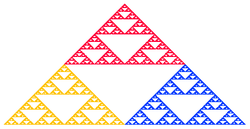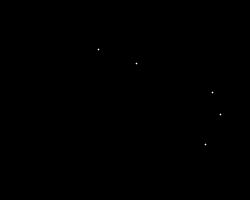Iterated function system


In mathematics, iterated function systems or IFSs are a method of constructing fractals; the resulting constructions are always self-similar.
IFS fractals, as they are normally called, can be of any number of dimensions, but are commonly computed and drawn in 2D. The fractal is made up of the union of several copies of itself, each copy being transformed by a function (hence "function system"). The canonical example is the Sierpinski gasket also called the Sierpinski triangle. The functions are normally contractive which means they bring points closer together and make shapes smaller. Hence the shape of an IFS fractal is made up of several possibly-overlapping smaller copies of itself, each of which is also made up of copies of itself, ad infinitum. This is the source of its self-similar fractal nature.
Definition
Formally, an iterated function system is a finite set of contraction mappings on a complete metric space.[1] Symbolically,
is an iterated function system if each is a contraction on the complete metric space .
Properties
Hutchinson (1981) showed that, for the metric space , such a system of functions has a unique compact (closed and bounded) fixed set S. One way of constructing a fixed set is to start with an initial point or set S0 and iterate the actions of the fi, taking Sn+1 to be the union of the image of Sn under the fi ; then taking S to be the closure of the union of the Sn. Symbolically, the unique fixed (nonempty compact) set has the property
The set S is thus the fixed set of the Hutchinson operator
The existence and uniqueness of S is a consequence of the contraction mapping principle as is the fact that
for any nonempty compact set in . Random elements of S may be obtained by the "chaos game" below.
The collection of functions generates a monoid under composition. If there are only two such functions, the monoid can be visualized as a binary tree, where, at each node of the tree, one may compose with the one or the other function (i.e. take the left or the right branch). In general, if there are k functions, then one may visualize the monoid as a full k-ary tree, also known as a Cayley tree.
Constructions

Sometimes each function is required to be a linear, or more generally an affine transformation and hence represented by a matrix. However, IFSs may also be built from non-linear functions, including projective transformations and Möbius transformations. The Fractal flame is an example of an IFS with nonlinear functions.
The most common algorithm to compute IFS fractals is called the chaos game. It consists of picking a random point in the plane, then iteratively applying one of the functions chosen at random from the function system and drawing the point. An alternative algorithm is to generate each possible sequence of functions up to a given maximum length, and then to plot the results of applying each of these sequences of functions to an initial point or shape.
Each of these algorithms provides a global construction which generates points distributed across the whole fractal. If a small area of the fractal is being drawn, many of these points will fall outside of the screen boundaries. This makes zooming into an IFS construction normally impractical.
Although the theory of IFS requires each function to be contractive, in practice software that implements IFS only require that the whole system be contractive on average.[2]
Examples

The diagram shows the construction on an IFS from two affine functions. The functions are represented by their effect on the bi-unit square (the function transforms the outlined square into the shaded square). The combination of the two functions forms the Hutchinson operator. Three iterations of the operator are shown, and then the final image is of the fixed point, the final fractal.
Early examples of fractals which may be generated by an IFS include the Cantor set, first described in 1884; and de Rham curves, a type of self-similar curve described by Georges de Rham in 1957.

History
IFS were conceived in their present form by John E. Hutchinson in 1981 [3] and popularized by Michael Barnsley's book Fractals Everywhere.
"IFSs provide models for certain plants, leaves, and ferns, by virtue of the self-similarity which often occurs in branching structures in nature. But nature also exhibits randomness and variation from one level to the next; no two ferns are exactly alike, and the branching fronds become leaves at a smaller scale. V-variable fractals allow for such randomness and variability across scales, while at the same time admitting a continuous dependence on parameters which facilitates geometrical modelling. These factors allow us to make the hybrid biological models... ...we speculate that when a V -variable geometrical fractal model is found that has a good match to the geometry of a given plant, then there is a specific relationship between these code trees and the information stored in the genes of the plant.
--Michael Barnsley et al.[4]
See also

- L-system
- Fractal compression
- Fractal flame
- Complex base systems
- Infinite compositions of analytic functions
Notes
- ^ Michael Barnsley, "Fractals Everywhere", Academic Press, Inc., 1988.
- ^ Draves, Scott (July 2007). "The Fractal Flame Algorithm" (pdf). Retrieved 2008-07-17.
{{cite web}}: Unknown parameter|coauthors=ignored (|author=suggested) (help) - ^ Hutchinson, John E. (1981). "Fractals and self similarity" (PDF). Indiana Univ. Math. J. 30 (5): 713–747. doi:10.1512/iumj.1981.30.30055.
- ^ Michael Barnsley, et al.,Template:PDF
References
- Draves, Scott (July 2007). "The Fractal Flame Algorithm" (pdf). Retrieved 2008-07-17.
{{cite web}}: Unknown parameter|coauthors=ignored (|author=suggested) (help) - Falconer, Kenneth (1990). Fractal geometry: Mathematical foundations and applications. John Wiley and Sons. pp. 113–117, 136. ISBN 0-471-92287-0.









